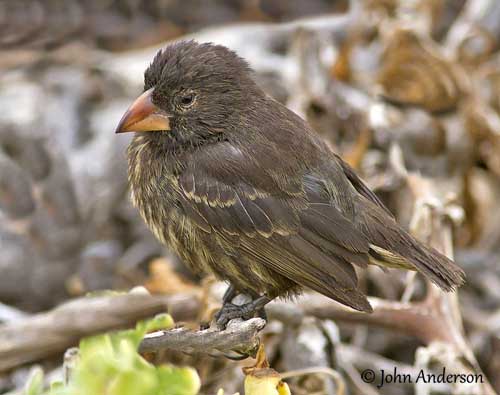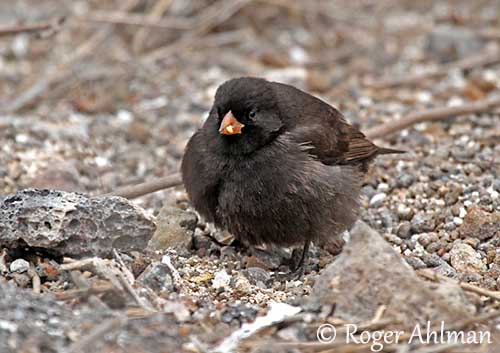
Fr: Géospize à bec pointu
All: Spitzschnabel-Grundfink
Esp: Pinzón de Darwin Picofino
Ita: Fringuello terricolo beccotagliente
Nd: Spitssnavelgrondvink
Sd: Spetsnäbbad Darwinfink
Photographers:
Roger Ahlman
Pbase Galleries Peru and Ecuador
John Anderson
John Anderson Photo Galleries
Text by Nicole Bouglouan
Sources:
HANDBOOK OF THE BIRDS OF THE WORLD Vol 16 by Josep del Hoyo- Andrew Elliot-David Christie – Lynx Edicions – ISBN: 9788496553781
BirdLife International (BirdLife International)
Neotropical Birds – Cornell Lab of Ornithology
Sharp-beaked Ground-Finch
Geospiza difficilis
Passeriformes Order – Thraupidae Family
Darwin’s Finches - Generalities
INTRODUCTION:
Like other Darwin’s Finches, the Sharp-beaked Ground-Finch is endemic to the Galapagos Islands. This one has fairly long, pointed bill. The three subspecies show considerable differences with different size and bill shape, and different behaviour too. One of the subspecies living on Darwin and Wolf Islands is known as “Vampire Finch”. Actually, it drinks blood from seabirds…
DESCRIPTION OF THE BIRD:
Biometrics:
Length: 11-12 cm
Weight: 13-20 g
The adult male of the nominate race has black plumage overall, except on wings and tail which are slightly browner, and the white-fringed undertail-coverts.
The sharply pointed bill has straight culmen. It is black during the breeding season, and becomes brown with orange base and yellow tip during the transition, and is finally orange-yellow outside breeding season. The eyes are dark brown. Legs and feet are blackish.
The female has dark olive-brown head, throat and upperparts, with greyish-olive fringing forming scaly pattern on upperparts and mostly streaked pattern on head. The upperwing is dark brown with buff fringing, whereas the tail is dark with greyish edges.
The underparts are heavily streaked dark brown and buff, darker on lower underparts. The undertail-coverts are whitish-buff.
On the head, the upper half of the eyering is buff.
Like in male, the bill varies in colour according to the breeding period. The eyes are dark brown. Legs and feet are blackish.
The immature male shows intermediate appearance between the streaked female and the black adult male.

SUBSPECIES AND RANGE:
There are currently three subspecies.
G.d. septentrionalis is found on Darwin and Wolf Islands, in extreme NW Galapagos islands. This one is larger than nominate. The bill is longer and more pointed, with more curved culmen. Female and young have darker plumage with cinnamon wingbars. (Now a full species)
G.d. difficilis (here described) occurs on Pinta and Genovesa in N Galapagos Islands.
G.d. debilirostris is found on Fernandina, Isabela, Santiago and Santa Cruz, in W and C Galapagos Islands. This race is large, with thick-based, sharply pointed bill, and large feet.
HABITAT:
The Sharp-beaked Ground-Finch is usually found in the highlands of the three larger islands, Fernandina, Santiago and Pinta. It occurs at high elevation in dense forests (Zanthoxylum fagara) with more open areas of low vegetation.
However, in the low islands of Darwin and Wolf, it frequents dry, arid scrub habitats with open vegetation and Opuntia cactus. On Genovesa, it is found in the deciduous forests with Bursera graveolens and Cordia lutea.
CALLS AND SONGS:
The Sharp-beaked Ground-Finch’s voice may differ according to the island.
The song is a single raspy note “ch-rrheeeewwww” or a doubled or tripled note “zheww-zheew, zheww-zheew”.
On Genovesa, the song is a nasal “tzh-waa tzh-waa” and the calls include a very high “tzeeeewwww”.
Usually, the male gives only one song type.
The songs of the forest populations are complex, whereas those of the low island populations are short with single structure.
However, Darwin and Wolf Island birds’ songs differ radically, with a simple buzzy trill uttered by the Darwin’s birds, and a short, multi-notes song on Wolf.
BEHAVIOUR IN THE WILD:
The Sharp-beaked Ground-Finch’s diet varies according to the islands. The birds of the low, dry islands feed primarily on seeds, and usually complete their diet with various other food items such as leaves, flowers, cactus pulp and insects.
The race “septentrionalis” of Darwin and Wolf Islands frequently drinks the blood from seabirds. It pecks at the base of a growing feather and then, it licks up the blood which begins to flow. This is due to the longer, sharper and more pointed bill of this race. It also feeds on seabirds’ eggs by cracking them open against rocks.
The populations living at high elevation also feed on seeds, and forage among the ground litter where they can find numerous invertebrates.
With the return of the breeding season, competition for food resources is intense between the different species. But the divergent beak shapes and sizes allow each species to feed on different food items.
The pair is monogamous and a small territory is maintained all year round. Songs, whistles and buzzes, are associated to courtship.
The Sharp-beaked Ground-Finch is resident, but the birds living at high-elevation perform some altitudinal movements, coming to lower and drier habitats after breeding. They have rounded wings because they only travel over short distances.
REPRODUCTION OF THIS SPECIES:
Usually, the breeding season is closely related to rainfalls. The highland birds breed during the wet season, whereas on Genovesa, they breed from January to May, soon after the first rains.
They can produce up to three clutches per season.
The male builds a small spherical structure with lateral entrance towards the top. The nest is placed in bush or cactus, and made with dry grasses and other plant materials.
The female lays 3-4 whitish eggs with dark markings. The incubation lasts 12 days. The juveniles fledge about 13-15 days after hatching.
PROTECTION / THREATS / STATUS:
The Sharp-beaked Ground-Finch is uncommon at high elevation, but common on the N arid low islands. The species is widespread and its populations are suspected to be stable.
Currently, the Sharp-beaked Ground-Finch is not threatened.
